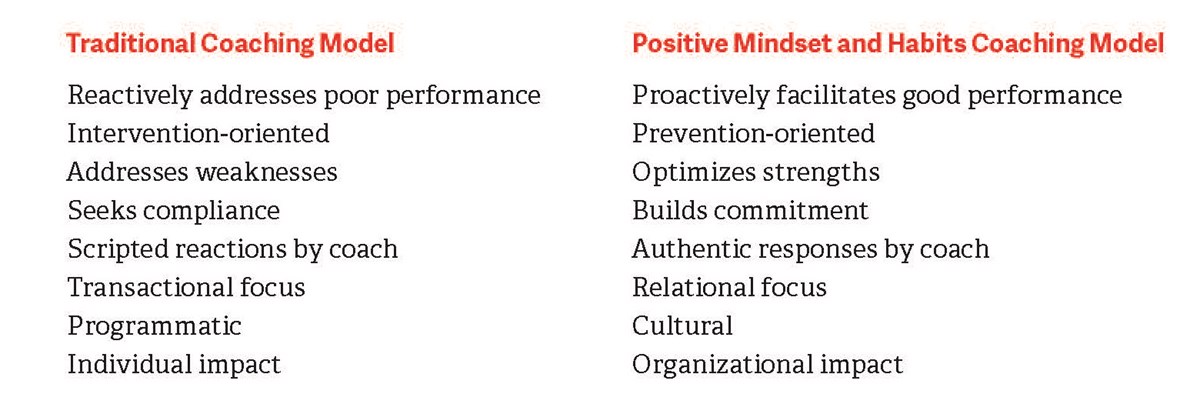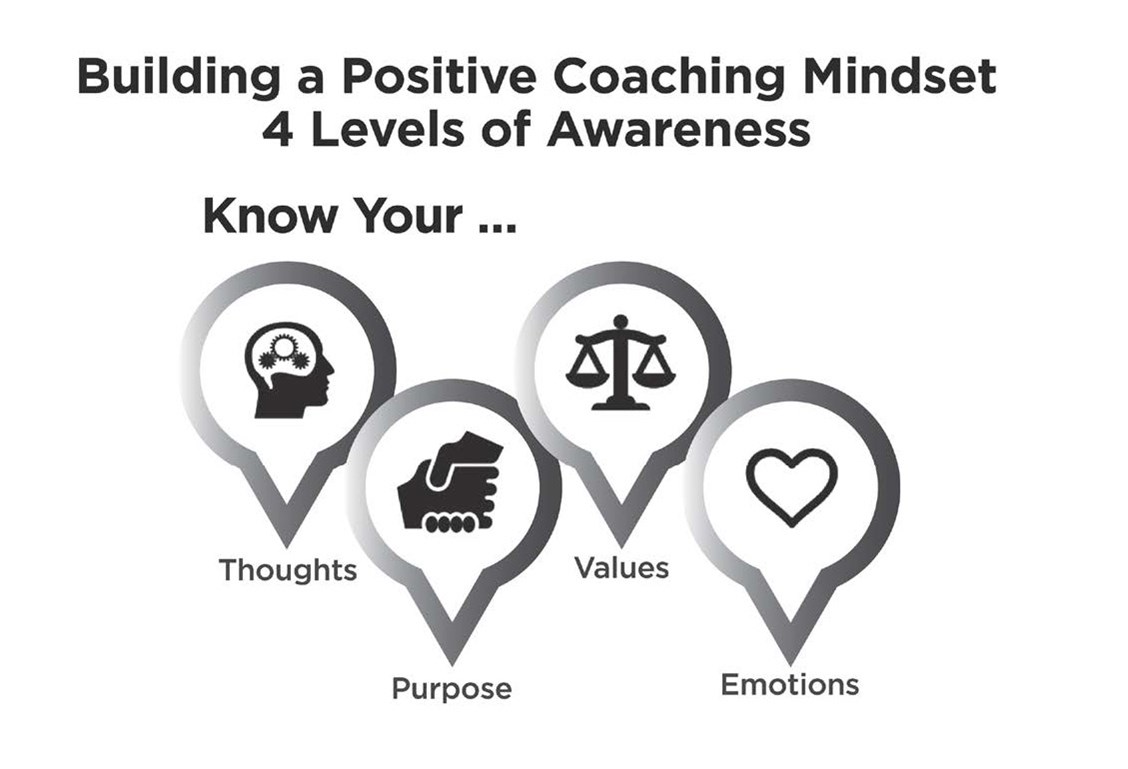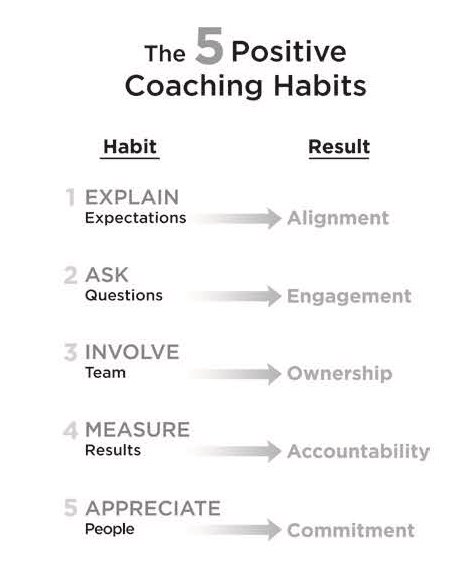The Power of Positive Coaching
January 23, 2019
"It wasn't too long ago that having a business coach was like having a scarlet letter on your professional suit. Back then, most coaching was remedial—there was a problem that needed to be fixed. Today, having a coach has been elevated in status. Business leaders have realized what professional athletes have always known—having a coach produces better results. That's a significant and necessary paradigm shift. Instead of symbolizing a problem, having a coach symbolizes a leader's willingness to develop and grow as a person and a leader."
It wasn’t too long ago that having a business coach was like having a scarlet letter on your professional suit.
Back then, most coaching was remedial—there was a problem that needed to be fixed. Today, having a coach has been elevated in status. Business leaders have realized what professional athletes have always known—having a coach produces better results. That’s a significant and necessary paradigm shift. Instead of symbolizing a problem, having a coach symbolizes a leader’s willingness to develop and grow as a person and a leader. Research from the Korn Ferry Institute supports this paradigm shift in perceptions about coaching.¹
The research found that most people rate “coaching and developing others” among the top three most important leadership competencies, according to 360-degree assessments. Although this competence is rated highly, it is consistently the least practiced competency worldwide. Why does this knowing/doing gap exist? Leaders say it is because they do not have enough time; they do not know a proven process; and/or they believe it will slow down their immediate performance.
These reasons—dare we say excuses—carry serious risks. If you don’t take the time to coach and develop team members now, you will pay for it later—guaranteed. Using a haphazard, gut-feel coaching approach, only when it is convenient, yields haphazard results. If you neglect coaching to drive short-term results, you will handicap your team’s ability to sustain performance over time. Coaching your team is the ultimate pay-me-now or pay-me-later leadership proposition. Applying a consistent approach to coaching others is fundamental to leadership excellence today.
A commitment to coaching also signals an organization’s willingness to invest in its people. In today’s environment of high-velocity change, factors like technology, product innovation, and unique distribution channels are fleeting advantages. In fact, the only sustainable competitive advantage is an organization’s talent, and that talent delivers its product or service. The coaching value chain directly links a leader’s ability to coach his or her team with sustained growth and profitability.
Inspiring leaders coach teams to:
- Build winning relationships internally and externally and
- Generate winning results that
- Produce sustained growth and profits.
“Applying a consistent approach to coaching others is fundamental to leadership excellence today.”
Unfortunately, not every organization has the resources to hire external coaches. Therefore, it’s critical for business leaders to be equipped as effective and inspiring coaches to their teams.
The Power of the Positive
We have all seen different types of coaches in action: the angry, red-faced coaches who yell at their teams for their failures; the disengaged, flat-line coaches who are physically present but not actively engaged in coaching; and the positive, exciting coaches who inspire their teams to strive for more despite the circumstances. Which type of coaching produces the best results?
The benefits of positive coaching carry “face validity,” meaning that even without research evidence, most people would agree that positive coaching generates real benefits (although there is abundant research to support the validity of positive coaching). People in general, regardless of generation or culture, respond better to positive interactions. We do more for those who appreciate us and invest in us simply because it feels good. Since we are creatures of pleasure, we repeat the behavior that created that good feeling. This creates a self-perpetuating cycle of reinforced positive behavior and positive results. As we see too frequently, an equally powerful negative cycle can be created.
Although some leaders argue that a negative response motivates people to perform, it also creates anxiety and triggers disengagement. A negative approach to coaching typically does not sustain long-term performance because people respond to negative leadership with compliance versus commitment. To be clear, we are not saying to avoid tough conversations. Rather, we recommend coaching for performance improvement with a positive mindset and habits to increase the chances of positive results.
Positive coaching is not a soft approach. To the contrary, it leverages insights about human dynamics and performance to generate hard results.
Positive coaching leads to:
- More focused effort (and less wasted mental and physical energy) because you and your team are aligned on expectations.
- More discretionary effort from the team because they are fully engaged.
- More ownership behavior and innovation because the team is involved in creating solutions.
- Greater accountability because the team knows their personal performance score.
- Deeper commitment from team members because the team feels genuinely appreciated and valued.
The results are a more productive team, improved relationships, and sustained positive performance. Here is how the traditional coaching model compares to the new positive mindset and habits coaching model.

Positive Mindset and Habits
Inspiring winning results and relationships is a two-dimensional challenge that involves a positive coaching mindset and positive coaching habits. Having only one or the other is insufficient to equip leaders to coach effectively and inspire their teams optimally. Most coaching books and workshops focus on skills and habits, which are essential. You can perform all the right skills, but without the right mindset, those skills and habits will not yield the response and results you want from your team. On the other hand, the right mindset is crucial, but without corresponding coaching habits, you will never see that mindset translated into coaching behaviors. A positive coaching mindset and positive coaching habits go hand in hand, and they have more than a proportional relationship. Your coaching mindset has a multiplier effect on your coaching habits. This relationship between mindset and habits can be expressed in a simple equation:
Positive Coaching Mindset
×
Positive Coaching Habits
=
Winning Results and Relationships
“A positive coaching mindset and positive coaching habits go hand in hand”
Positive Coaching Mindset
Your mindset has a significant influence on how you perform, lead, and coach. Psychologist Carol Dweck asserts, based on decades of research, that how we see ourselves is a major factor in what we ultimately achieve.² You will rise to the level of expectations of yourself. What is your current mindset? Do you think you can change, improve, achieve, lead, and coach with excellence?
Your mindset also has a dramatic impact on those you coach. People rise to the level of your expectations for them. A recent study by Korn Ferry Institute found that 65 percent of female chief executive officers (CEOs) from large companies realized they could be a CEO only after someone told them they could be a CEO.³ At first glance, this statistic might seem shocking. But consider how often you have observed an average employee under an average leader begin to flourish once he or she is assigned to an inspiring leader who sees the potential in that employee. Just like these female CEOs, you and those you coach will rise to the level of expectations. Your mindset about yourself and others is one of the very best predictors of the winning results and relationships you will inspire. It is the coach’s mindset and expectations that make all the difference.
Your mindset predisposes you to see behaviors that reinforce your mindset, negative or positive. Sure, your employees can be frustrating and noncompliant at times. That’s why it is so important to bring a positive mind-set to the relationship. If your mindset is, “This team member is difficult and not collaborative,” you are already predisposed to look for, and predictably find, behaviors that reinforce this negative mindset. If your mindset is, “I think this employee can stretch herself and really lead this project successfully,” you will likely look for and find skills and behaviors that support your mindset.
This is known as confirmation bias, which is the tendency to search for, interpret, favor, and recall information in a way that confirms your pre-existing beliefs. As a coach, consider what you will see and the different outcomes you can expect if you choose the positive coaching mindset on the left versus the negative one on the right.

Researchers illustrated the power of mindset by proving that managers who used a strength-based approach with their employees helped to improve employee performance by 36.⁴ percent. On the other hand, managers who focused primarily on the employees’ weaknesses helped to decrease their employees’ performance by 26.8 percent.4 If you are committed to winning results and relationships, then choosing a positive coaching mindset is an easy choice because it is the only choice.
Our company logo is a group of three stacked L’s, which represent the three levels of leadership: personal, team, and organizational. The logo represents our belief that personal leadership drives team leadership, which in turn drives organizational leadership. Excellence, like leadership, is built from the inside out. Your organization’s excellence will rarely exceed your team’s excellence, and your team’s excellence will rarely exceed your personal excellence.
Therefore, the most important question a leader should ask is: “What am I currently doing to improve my personal leadership?” Inspiring coaches work on themselves before they work on their teams. It starts inside with an understanding of yourself. A positive coaching mindset is built on a foundation of self-knowledge. Inspiring coaches intentionally, courageously, and consistently deepen four levels of self-awareness:
- Know Your Thoughts
- Know Your Purpose
- Know Your Values
- Know Your Emotions
Keen awareness at these four levels enables you to be more personally effective, authentic, and credible. Just as importantly, seeking greater self-awareness creates a culture that is conducive to coaching and a team that is more responsive to your coaching.
“Your organization’s excellence will rarely exceed your team’s excellence, and your team’s excellence will rarely exceed your personal excellence.”

Positive Coaching Habits
Your coaching mindset will set the limits for the level of impact your coaching habits will have on your team’s performance. A positive coaching mindset enables you to authentically and effectively apply the coaching habits and reap the ultimate benefit: winning results and relationships. On the other hand, with a negative coaching mindset, your coaching habits will inhibit your ability to inspire your team and yield less-than-optimal results.
There are five positive coaching habits. When they are applied with a positive coaching mindset, you will predictably inspire winning results and relationships. These five habits give your team the biggest boost if applied in sequence, but you should still use your knowledge of each team member to determine when to accelerate through or spend more time on a specific habit.
The root meaning of the verb “to coach” means to bring a person from where he or she is to where he or she wants to be. The inspiring coach focuses more on developing a person’s natural gifts, so each team member can realize his or her potential while shoring up weaknesses to help each team member master his or her job.
“A positive coaching mindset enables you to authentically and effectively apply the coaching habits and reap the ultimate benefit: winning results and relationships.”
Consider the role of a football coach. He sets clear expectations for his team with a game plan to win. He asks players if they have any questions to ensure they are clear about their respective roles on the team. He also asks them questions like, “How can you improve your performance or overcome a certain obstacle?” Then during the game, he involves them in changing the game plan, if necessary, based on what they are seeing on the field. The coach also observes and measures each player’s performance (e.g., number of tackles, yards gained, etc.). Finally, the coach gives constructive feedback and recognition, so his players can elevate their performance in the next game.
These are the five positive habits that inspiring coaches in business practice to build winning teams:
- Inspiring coaches explain expectations. They take the time to ensure alignment with their teams before moving forward.
- Inspiring coaches ask questions. They ask to clarify a problem or ask for ideas and suggestions. Asking questions ignites employee engagement.
- Inspiring coaches involve team members in creating solutions to improve their work. This enlists ownership because people are committed to things they help create.
- Inspiring coaches measure results diligently to boost team accountability.
- Inspiring coaches appreciate people. This builds commitment to sustaining and improving results.
Using each of these habits in concert elevates team performance.

The left side of this model shows five positive coaching habits that inspire winning results and relationships. This is the side of choice.
Each day, coaches choose whether to take these actions. If you choose your habits, then you must take responsibility for your results. You are responsible for the choices you make and for the results you ultimately achieve.
“These positive coaching habits are based on natural human dynamics and needs. That’s why it does not look like rocket science and seems so simple.”
If you choose not to build these coaching habits, you must accept these predictable outcomes:
- Instead of Alignment, you get Confusion
- Instead of Engagement, you get Disengagement
- Instead of Ownership, you get Entitlement
- Instead of Accountability, you get Blame
- Instead of Commitment, you get Compliance
These positive coaching habits are based on natural human dynamics and needs. That’s why it does not look like rocket science and seems so simple. That’s also why these habits work across generations, industries, and cultures; they meet universal human needs in the workplace. It is easy for one thing or another to get in the way of these habits, but if you say “yes” to those things, you are saying “no” to winning results and relationships. Positive coaching is not a “salt and pepper” practice. You cannot sprinkle on a little explaining here and appreciation there and expect winning results or relationships. You must perform these habits consistently. If world-class athletes need a coach every day, why wouldn’t your team?
Each day you’re making a choice about your team’s alignment, engagement, ownership, accountability, and commitment.
Let’s see how a team leader, Lexi, and an employee, Cameron, progress through the five positive coaching habits:
Lexi: “Hey, Cameron. I’m glad I bumped into you. I wanted to talk to you about something. We really need to improve our response time on special orders. If we do, we will create a positive ripple effect with our core customer, which will drive sales, and that’s good for all of us.” (Lexi is explaining expectations and consequences.)
Cameron: “OK, I understand.” (Cameron is simply observing.)
Lexi: “You’re on the front lines with this issue. Why do you think our response time has increased lately?” (Lexi is asking questions.)
Cameron: “Well, the new system migration has had its bumps. But I think the bigger issue is that we weren’t prepared for the recent promotional campaign for our VIP customers. Our call volume from VIPs has increased by 80 percent for special orders over the same period last quarter.” (Cameron is becoming engaged.)
Lexi: “We need to discuss your ideas on how we can get back on track. Our response time has a direct impact on our bottom line, so I’ll give you whatever support you need to take care of this.” (Lexi is involving Cameron.)
Cameron: “That sounds great. Let me get some input from my team and send you some recommendations before our meeting. I’m confident we can identify a good solution and implement it quickly.” (Now Cameron is owning the solution.)
Lexi: (After they meet.) “I like your recommendations, Cameron. Let’s measure the key metrics you identified each week for the next month and touch base to see if we need to tweak anything.” (Lexi is observing performance and providing feedback along the way.)
Cameron: (next month) “Looks like we’re in good shape. Our response time has gone down each week, and we have been at our target of 20 percent reduction in response time for the past two weeks. How about if I just keep an eye on things now and send you a quick scorecard each month to ensure we sustain the changes?” (Cameron is taking accountability for the results.)
Lexi: “That sounds great, Cameron. I am really impressed with how you took control of this challenge, involved your team, and executed the solution. I really appreciate your efforts. Well done!” (Lexi is appreciating Cameron and his performance.)
Since Lexi applied the five positive coaching habits, Cameron is feeling a sense of personal commitment to his job and to his coach. Plus, he is motivated to deliver results so that he can be reinforced by his coach again, because it feels good. Everyone likes to be reinforced for their performance.
Inspiring coaches integrate the positive coaching habits into their daily interactions, realizing it is the best formula in building winning results and relationships.
1. Kevin Cashman, “Leadership from the Inside Out: Eight Pathways to Mastery,” Forbes.com, Oct. 8, 2017
2. Carol S. Dweck, Mindset: The New Psychology of Success, (New York: Ballantine Books, 2007).
3. Meghan Walsh, “Their Breakthrough Formula: Women CEOs,” Korn Ferry Briefing Magazine, Feb. 2018.
4. P. Alex Linley, Linda Woolston, and Robert Biswas- Diener, “Strengths Coaching with Leaders,” International Coaching Psychology Review 4(1) (2009): 37–48.


